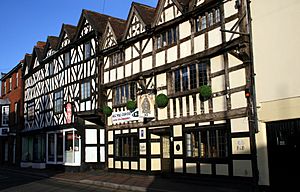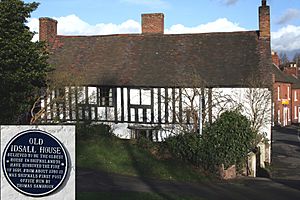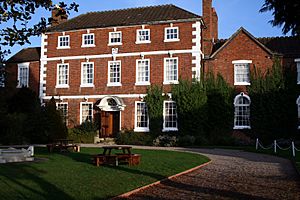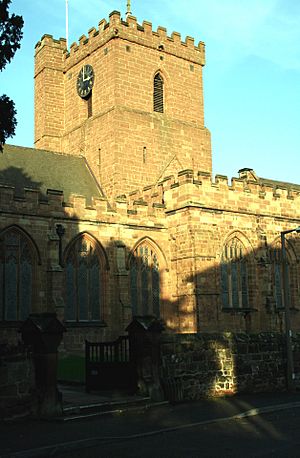Shifnal facts for kids
Quick facts for kids Shifnal |
|
|---|---|
 Market Place and Park Street |
|
| Population | 7,009 (2017) |
| OS grid reference | SJ7407 |
| Civil parish |
|
| Unitary authority |
|
| Ceremonial county | |
| Region | |
| Country | England |
| Sovereign state | United Kingdom |
| Post town | SHIFNAL |
| Postcode district | TF11 |
| Dialling code | 01952 |
| Police | West Mercia |
| Fire | Shropshire |
| Ambulance | West Midlands |
| EU Parliament | West Midlands |
| UK Parliament |
|
Shifnal is a market town and civil parish in Shropshire, England, about 4 miles (6 km) east of Telford, 17 miles (27 km) east of the county town of Shrewsbury and 13 miles (20 km) west-northwest of the city of Wolverhampton. It is near the M54 motorway (Junction 4). At the 2001 census, it had a population of 6,391, increasing to 6,776 at the 2011 census.
Contents
History
Early medieval time
The town, also once known as "Idsall" (relating to potential Roman links), most probably began as an Anglian settlement, established by the end of the 7th century.
Shifnal is thought to be the place named "Scuffanhalch" in a 9th-century charter, as a possession of the monastery at Medeshamstede (later Peterborough Abbey). Though this seems a dubious claim, and the ancient charter is in fact a 12th-century forgery, the full picture is more complex. Sir Frank Stenton considered that "Scuffanhalch", along with "Costesford" (Cosford) and "Stretford", formed part of a list of places which had once been connected with Medeshamstede; and the charter purports to have been issued by King Æthelred of Mercia, during much of whose reign the bishop of Mercia was Sexwulf (or "Saxwulf"), founder and first abbot of Medeshamstede.
The first part of the name "Shifnal" is reckoned to be a personal name, "Scuffa", while the second part, from "halh", means a valley, thus describing the town's topography.
Unusually, the name of the town has alternated through the centuries between Idsall and Shifnal. Idsall is mentioned in a 9th-century charter as "Iddeshale", meaning "Idi's nook" or corner. A nook is said to be an area of land of approximately 20 acres (81,000 m2). It is often conjectured that the two names of Idsall and Shifnal were names of settlements on the east and west sides respectively of Wesley Brook, a brook which runs through the town, and is a tributary of the River Worfe. In the 19th century, J. C. Anderson, in his Shropshire its Early History and Antiquities, wrote that Idsall means "Hall of Ide", and that Shifnal is "Hall of Sceafa".
A Key to English Place-names has an entry for Shifnal that reads '*Scuffa's nook of land'. It was also known as Iddeshale, '*Idi's nook of land'.
The oldest part of the town is said to be the area around St Andrew's Church, Church Street and Innage Road where excavations have turned up evidence of ancient buildings.
Norman
The village, as it would have been in 1086, is recorded in the Domesday Book within the hundred of Alnodestreu. The initial part of the entry states:
Robert, son of Theobald, holds of Earl Roger Iteshale. Earl Morcar held it."
This entry records that possession was lost by the Saxon Earl Morcar when he rebelled against the Norman conquerors.
The church of St Andrew has a Norman chancel and was almost certainly built on the site of an earlier church. It was a collegiate church or minster with a chapter of priests ministering to the needs of congregations in outlying settlements. St Andrew's lost its collegiate status when it was given to Shrewsbury Abbey c. 1087.
Plantagenet period
In 1245 Walter de Dunstanville, the lord of the manor, applied to King Henry III for, and was granted, a market charter for the town. Walter then laid out a broad market street that is Broadway, Bradford Street, Market Place and Park Street for the markets. This area to the east of the stream was known as Shifnal and gradually this name superseded Idsall as the town's name.
Tudor times
Shifnal had something of an early industrial revolution during the late 16th century with the construction of a charcoal fired blast furnace near to the Manor House.
A fire swept through the town on 7 July 1591, setting alight the roof of the church. The fire is thought to have been started by a maidservant's candle that accidentally set fire to some hanging flax. The fire devastated many, if not all, of the buildings east of the brook now known as Wesley Brook. The church and the timber-framed Old Idsall House at its foot to the east (a listed building), are said to be the only two buildings to have survived the fire that destroyed the rest of the settlement. This is now commemorated by a blue plaque fixed to the wall of the house. After the fire, Elizabeth I sent money to help rebuild the town.
18th and 19th centuries
Thomas Beddoes, a well-known physician, was born in 1760 at Balcony House, named for a room projecting above the roof line, on the east side of Market Place. This building later became the Star Hotel.
A Baptist church was established in Aston Street at the end of the 18th century, but it closed down before the 20th century.
Thomas Telford upgraded Watling Street, the turnpike road that passed through the town, in the late 18th century. This road carried traffic from London to Shrewsbury, Chester and Holyhead for Ireland. It is reported that as many as 18 coaches a day called at Shifnal. Passengers could rest from their travels at three coaching inns the Jerningham Arms, the Star Hotel and the Unicorn.
During this period of prosperity many new houses were built, lending Shifnal a Georgian air. The name Idsall was still used to distinguish the area around the St Andrew's Church and the Manor from the market and commercial area of Shifnal.
The railway line from London and Birmingham to Holyhead was constructed through Shifnal at high level in the late 1840s. A station was built, but the opening of the line on 12 November 1849 brought an abrupt end to the already declining coaching traffic. The viaducts constructed were cast by Horseley Ironworks.
The 20th century
The Star Hotel was demolished after a fire in 1911. The Eight Bells or Ring of Bells was occupied in 1911 by the Pitchford family, descendants of the nobility who took their name from the area of Pitchford in Shropshire. Herbert James Pitchford ran the Eight Bells among other public houses. He served in the King's Shropshire Light Infantry, and died in Flanders in the First World War. His name appears on the Menin Gate in Belgium and on the war memorial in St Andrew's Church, Shifnal, near the Eight Bells public house. Today the building is occupied by the Oddfellows Wine Bar.
The railway bridge over Market Place was rebuilt in 1953: the open spandrels of the original arch were replaced with a plain lined flat panel construction.
The town expanded further during the 1960s.
The town's branch of Barclays Bank was targeted by robbers on 6 May 1991. They drilled into the strongroom and escaped with £50,000.
Culture
Charles Dickens, whose grandmother was reputedly employed at nearby Tong Castle, visited the town on several occasions and many believe that the buildings in his book, The Old Curiosity Shop, were based on those in the town. Shifnal Historical Society report that he was very taken with the architecture of the town, and for that reason, he based The Old Curiosity Shop on the Unicorn public house, now known as Naughty Nell's.
Mary Arnold, later known as the writer Mrs Humphry Ward, went to boarding school in the town at Rock Terrace. Her schooldays gave background for one of her later novels, Marcella (published 1894).
It is widely believed that Shifnal had some inspiration for P. G. Wodehouse's fictional town Market Blandings – or rather, the town is mentioned numerous times in the Blandings Castle saga.
In 1968, the Shifnal Carnival was launched, a revival of the Shifnal Club Day - itself deriving from an annual parade by the 'Dove Club' friendly society. Taking place on the last Saturday of June, a funfair is set up on the main street, as well as the usual procession.
In 2010, after research as part of the town plan, the Shifnal Festival was revived due to residents expressing interest for a festival of arts, culture and entertainment.
In the 1990s and 2000s Shifnal become well known throughout the region for its annual Christmas lights display, which attracted visitors from the outside the town.
Places of interest
Churches
- Church of England: St Andrew's Church on Church Street has a Norman chancel with an Elizabethan double-hammerbeam roof and was almost certainly built on the site of an older Saxon church. Its churchyard contains war graves of 13 soldiers of the First World War and 4 of the Second World War, who are all commemorated by a Screen Wall memorial.
- Methodist: Trinity Church, Victoria Road
- Roman Catholic: St Mary’s Church, Shrewsbury Road
It also has, through Churches Together in Shifnal, its own Christian bookshop and drop-in centre, Oasis.
Communal services
A community library run by the council is located on Broadway. The Millennium Sensory Garden lies between St Andrew's Church and Innage Road and contains the town's war memorial. The garden is voluntarily maintained by a dedicated group of committee members and friends and obtained the Queen's Golden Jubilee Award 2003 and Green Pennant Award 2007/08. Shifnal Police Station is located behind the library on Broadway.
Pubs, restaurants and hotels
Naughty Nell's public house, a restored 16th century coaching inn, originally known as the Unicorn, claims to have been the home of Nell Gwyn and her renowned bedchamber. It had been known by her name itself for some time. The building was sold in auction recently (2011) and is now vacant and awaiting some works.
Sports
There are several sporting facilities in Shifnal, including the Idsall Sports Centre, which is attached to Idsall School; the school, in the past, receiving a number of prominent football celebrities from the nearby FA School of Excellence at Lilleshall.
The town is also home to sporting clubs which play sports including:
- Table tennis
- Ice hockey
- Rugby
- Football
- Tennis
- Cricket
Shifnal Town F.C. currently has a place in the West Midlands (Regional) League, whilst Shifnal United are in the lower Mercian Regional Football League (Premier Division).
Shifnal was formerly home to a squash club and swimming pool for 35 years, but this has since closed, and following its demolition has been replaced with a housing development.
Twin cities
- Machecoul,
 France.
France.
Education
There are several pre-school nursery and day centres in the town, as well as two primary schools: Shifnal Primary School, on Curriers Lane; and St. Andrew's Church of England Primary School, on Park Lane. The town has two further schools, Idsall School, in Coppice Green, a comprehensive secondary school; and Young Options College, in Lamledge Lane, an independent specialist secondary school.
Transport
Buses are provided by Arriva Midlands and Banga Buses providing links to Telford, Wolverhampton and Bridgnorth.
The main railway station is on the Shrewsbury-Wolverhampton Line with services to Shrewsbury, Telford, Wolverhampton and Birmingham New Street.
Notable people
- George Talbot, 4th Earl of Shrewsbury KG, KB, PC (c. 1468 in Shifnal – 1538) son of John Talbot, 3rd Earl of Shrewsbury and Lady Catherine Stafford, daughter of the Humphrey Stafford, 1st Duke of Buckingham
- Edward Bromley (1563-1626), judge and politician, lived at mansion called 'Shiffnal Grange'
- Thomas Brown (1662-1704) satirist poet, of "facetious memory" born son of farmer in Shifnal.
- Thomas Beddoes (1760 in Shifnal – 1808) physician and scientific writer, a reforming practitioner and teacher of medicine and worked to treat tuberculosis
- William Hollins (1763 in Shifnal - 1843) architect and sculptor
- Henry Hill Hickman (1800-1830) surgeon and pioneer of anaesthetics, lived and practiced in Shifnal in 1824.
- Hannah Cullwick (1833 in Shifnal – 1909) nursemaid and diarist.
- Mary Augusta Ward CBE (1851–1920) novelist used her married name, Mrs Humphry Ward, brought up in Shifnal
- Captain Basil Brooke DSO & Bar (1882 in Shifnal – 1929) a Royal Navy mine clearance officer.
- Sir Thomas Ingram Kynaston Lloyd GCMG KCB (1896 in Shifnal – 1968) Permanent Under-Secretary of State for the Colonies from 1947 to 1956
- Peter Reynolds (1939 in Shifnal - 2001), archaeologist, the first director of Butser Ancient Farm
- Kevin Mulligan (born 1951 in Shifnal) philosopher, working on ontology, the philosophy of mind, and Austrian philosophy
- Andrew Burn (born 1954 in Shifnal) professor and media theorist, developed the theory of the Kineikonic Mode
- Stephen Harris (born 1968, Shifnal) music producer and mixer.
Sport
- Edwin Bennett (1893 in Shifnal – 1929) an English cricketer, who played four first-class matches
- Bert Williams MBE (1920–2014) international football goalkeeper at Wolverhampton Wanderers F.C., lived near Shifnal
- Reg Attwell (1920 in Shifnal – 1986) professional footballer mainly for Burnley F.C.
- Jack Taylor OBE (1930-2012) referee at 1974 FIFA World Cup Final, lived at Shifnal
- Peter Alan Baker (born 1967 in Shifnal) is an English professional golfer
- Peter Lamsdale (born 1971 in Shifnal) an English cricketer, played for Berkshire
Images for kids
See also
 In Spanish: Shifnal para niños
In Spanish: Shifnal para niños











